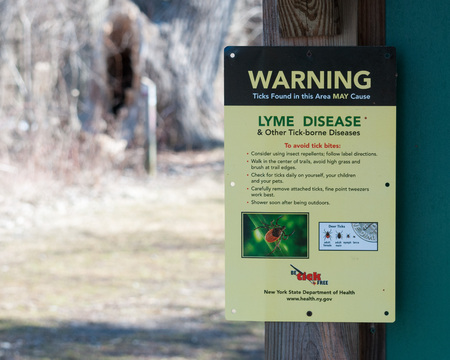
Scott Santarella, Global Lyme Alliance CEO, talks about Lyme disease with Kacey Morabito Grean on 100.7 WHUD radio. Below is an excerpt.
Kasey Morabito Grean, WHUD: Let's talk about the epidemic. This just came out of the blue it seems, maybe 15 years ago. Is my perception right? Scott Santarella, Global Lyme Alliance: Yeah. Historically, Lyme disease has been around really since the beginning of time, but wasn't really at epidemic levels until the last maybe 10 to 15 years. The CDC just recently upped the numbers from a couple years ago that they were saying it was about 35,000 people a year get diagnosed with the disease. Now it's over 330,000 people get diagnosed with the disease. We've got a serious issue at hand. We're trying to do our best to identify options to improve overall diagnostic abilities associated with the disease and obviously treatment pathways. Right now most of the treatments are antibiotics. They don't always work. KMG: Three hundred thirty thousand people diagnosed every year. That's a huge jump ... SS: Correct. KMG: ... from past years. What has happened to our bodies that we're not fighting this off like we used to? SS: I think part of it's just been better overall reporting on the disease. That was one of the reasons for the jumps. The other issue is Lyme disease is what they call a ghost disease. It masks itself as other diseases in your body. You may have headaches, or flu-like symptoms, arthritis symptoms, even symptoms associated with early onset dementia, or Alzheimer's, and things like Crohn's, and colitis, and other issues that you have that you may think are those diseases, but when you take the treatments that are available for those illnesses, they don't seem to work. They seem to pile up and get worse. Often times that's a precursor to someone who probably has Lyme disease and just doesn't know it. The challenge we have with that is we don't have a real good diagnostic tool that definitively says "yes" or "no" that you have Lyme. You don't always find the bullseye bite that most people are familiar with. In fact, many people who get diagnosed with Lyme disease, or get Lyme disease never ever find the bite, or the tick. KMG: All right. You think for the most part then the 330,000 people being diagnosed, that's just because more people are getting tested now. SS: I think it's more people are aware of it. More people are being tested. Actually, it's a growing epidemic. We're finding Lyme disease cases now in every state of the country, huge issues obviously in the northeast, but all up and down the Atlantic coast, big issues in Florida now and a tremendous amount of incidence increases in the Midwest, especially Wisconsin and Michigan and, quite frankly, California, especially northern California, huge issues with Lyme disease in those areas of the country. KMG: All right. And these ... SS: Texas, too. KMG: ... and these come from a tick? SS: It comes from a tick, yeah. Lyme disease is the most common form, but there's other what they call co-infections of the disease that you can get from tick-borne bites. KMG: I think everyone listening knows someone who's had Lyme disease. SS: You're right. KMG: I have a girlfriend and she's young. She's had a hip replacement because of what Lyme disease did to her years ago. Can you talk about some of the things that happen when the person has Lyme disease? SS: One of the biggest challenges that we have is if someone's diagnosed early and you catch Lyme disease at the acute phase, often times antibiotics will work and you'll be okay. We've got probably about 40% of the people who diagnosed with Lyme disease are what we call chronic sufferers, or persistent sufferers where the disease actually takes many, many years to diagnose; gets imbedded in their immune system and throughout their body and starts to wreak havoc within the overall body structure. You have people who've been diagnosed when they were late adolescent, early teens. They find that they're incredibly sick into their twenties. It's not until then that they find out they have Lyme disease. By that time, they have a tremendous amount of issues, neurological symptoms where they have brain fog and can't think properly, incredible fatigue, tiredness. Then you have issues where some people, like your friend, get Lyme disease so bad that they had hip replacements and/or need knee replacements, because of joint pain and other issues they're suffering from. This chronic form of the disease is really what is baffling a lot of the scientists. It's a real area of focus for us in terms of the research that we fund. KMG: Because the only way to protect yourself against it is to cover up, maybe wear repellent. SS: Yeah, you're right, cover up, wear repellent, and check yourself ( more on Lyme disease prevention here). What they say is if you're outside for extended period of times and you think you're in tick-infested areas, one of the things they do recommend is to take off all your clothes and throw them in the dryer. The heat of the dryer kills any ticks that will be on your clothes and to jump in the shower real quick and try to wash whatever may be on you / off you. It is also tick checks, check areas of your body where ticks tend to find their ways, armpits, soft parts of your body, your legs, obviously, ankles, if you've been outside. Repellents do work. It's more or less just being aware, being aware of your surroundings. Don't be afraid to go outside, but just be very conscious of it, if you've been outside to check yourself. That's certainly the first step. Listen to the entire interview. [audio mp3="http://globallymealliance.org/wp-content/uploads/2017/03/WHUD-Interview_Scott-Santarella_032417.mp3"][/audio]





-2.jpg)
